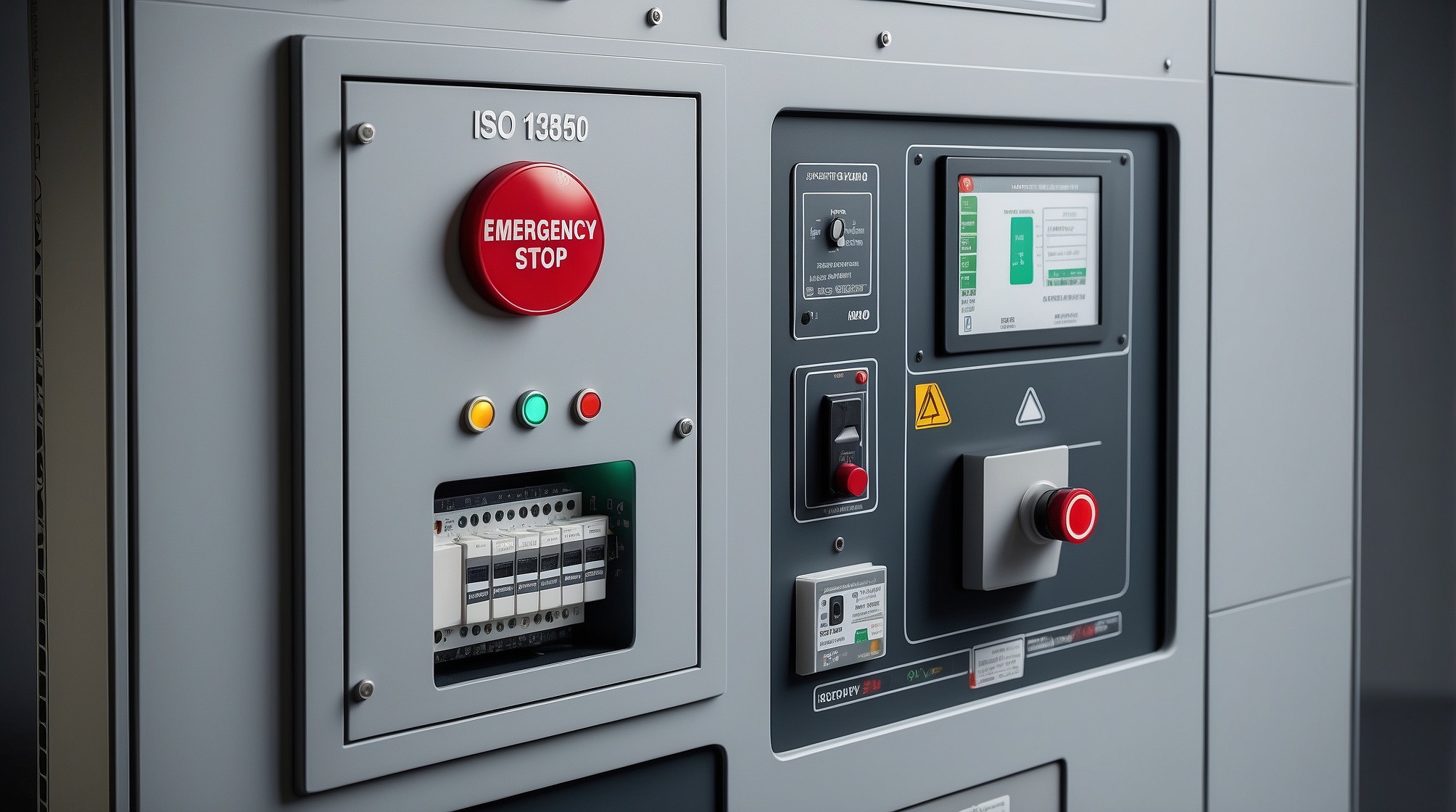1. Introduction to ISO 13850

ISO 13850 defines the emergency stop function requirements for machinery, ensuring that operators can halt machine operation safely and efficiently during emergencies. In many industrial environments, machinery operates at high speeds or exerts great force, making the ability to stop them instantly a critical factor in reducing injury, damage, or even fatalities.
ISO 13850 establishes the criteria for an effective emergency stop system, emphasizing that the emergency stop should be designed to function reliably in any operational mode, independent of the control system’s normal status.
2. Emergency Stop Function Overview
2.1 Importance of Immediate Removal of Power
The emergency stop function aims to achieve the cessation of machine motion or processes to mitigate hazards. This often involves the removal of power to actuators. By ceasing all movements as quickly as possible, this feature minimizes the risk of injuries or further hazards caused by the machinery.
2.2 Different Types of Power Removal
Emergency stops can remove power in several ways based on the machine’s design and operational requirements. The method chosen directly affects how the machine halts its operations:
- Electrical Power Removal: The most common method, where power to motors and electrical systems is cut off.
- Pneumatic Power Removal: In systems using pneumatic actuators, the air supply is vented, causing the machine to lose control pressure.
- Hydraulic Power Removal: For hydraulic systems, the hydraulic pressure is released, causing the equipment to stop.
3. Performance Level of Risk Assessment: ISO 12100
ISO 12100 provides the framework for risk assessment in machinery design and functionality. The emergency stop function must be designed to meet the necessary performance level established by the machine’s risk assessment. This involves evaluating the machinery’s inherent risks, operational factors, and the likelihood and severity of potential hazards. The goal is to ensure the emergency stop meets or exceeds the required performance level to prevent accidents.
Key risk assessment factors include:
- Avoidability
- Severity
- Likelihood of Incidence
4. Stop Categories Based on IEC 60204-1 and NFPA 79
The stop categories in ISO 13850, defined by IEC 60204-1 and NFPA 79, describe how the machine behaves during an emergency stop. These categories ensure that machinery halts according to a defined and safe procedure. There are three distinct stop categories:
4.1 Category 0: Uncontrolled Stop
Category 0 is characterized by the immediate removal of power to actuators, leading to an uncontrolled stop. This method is often the simplest and most effective in terms of halting machine motion quickly, but it may not be suitable for all applications due to the lack of control over the machine’s deceleration.
Example: Pulling the power plug of a machine, causing it to coast to a halt without any control over its braking mechanism.
Characteristics:
- Power is removed instantly.
- The machine decelerates naturally without external control.
4.2 Category 1: Controlled Stop with Power
In Category 1, the emergency stop involves a controlled deceleration of the machine, followed by the removal of power. This method allows the use of powered brakes or controlled ramping down of motion to ensure the machine halts safely before power is fully removed.
Example: A machine using electric drives where deceleration is controlled by the drive before the power is cut off.
Characteristics:
- Power is maintained during deceleration.
- The machine is brought to a safe stop before the power is removed.
4.3 Category 2: Controlled Stop with Power Left Available
Category 2 involves stopping the machine in a controlled manner but leaving the power to the actuators available. This stop method is often used in normal operational procedures, where the machine needs to stop but be ready for immediate restart without a reset.
Example: A normal production stop where the machine halts, but power remains on for continued operation.
Characteristics:
- The machine comes to a controlled stop.
- Power remains available for immediate restart.
Image Placeholder: Illustration of different stop categories (Category 0, 1, and 2) and their functions.
5. Key Requirements for Emergency Stop Functions
ISO 13850 outlines several key requirements that every emergency stop function must fulfill to ensure both operator safety and machine compliance:
5.1 Operator Accessibility
The emergency stop must always be accessible and within reach of the operator. Placement should be strategic, ensuring that the operator can engage the emergency stop without delay, regardless of where they are working.
- Emergency stop buttons should be large and prominent.
- Color coding (usually red) helps ensure easy identification.
Image Placeholder: Diagram showing ideal emergency stop button placement on machinery.
5.2 Prevention of Machine Restart
A critical feature of the emergency stop function is that it prevents the machine from restarting until the emergency stop button has been reset. This requirement ensures that the machine cannot accidentally resume operation after an emergency stop, maintaining safety until the situation has been fully assessed and resolved.
5.3 Overriding All Modes of Operation
The emergency stop must override all operational modes, meaning it should function independently of the current state of the machine. Whether the machine is in manual, automatic, or any other mode, the emergency stop function must immediately halt all activities.
6. Conclusion
In any industrial environment where machinery plays a vital role, having a reliable emergency stop system is crucial for worker safety. ISO 13850 sets the foundation for designing emergency stop systems that are both effective and compliant. Understanding stop categories, risk assessment criteria from ISO 12100, and how power is removed in emergencies helps to implement better safety protocols in industrial settings.
7. We’re here to answer your questions on Machinery Safety
At Megalab Group Inc., we specialize in testing and verifying compliance with ISO 13850, ensuring that your machinery meets the highest standards of safety. Our team of experts offers comprehensive assessments, including risk analysis and functional testing of emergency stop systems.
Contact us today to schedule your machinery safety compliance testing or visit our ISO 13850 Testing Service Page to learn more about how we can assist your business in ensuring a safer work environment.
Got a Question?
We’re here to answer your questions and help you get started right away. Call or send us a message anytime.

Megalab Group
Megalab offers ISO 17025 A2LA Accredited, EMC, Product Safety, Mechanical & Laboratory Testing Services. Megalab Group Inc. and its team are committed to meet and exceed our customers’ expectations as an industry leader in environmental and related regulatory testing services, through constant business improvement while upholding the highest integrity and quality in standards of all services we provide.
Learn more at www.megalabinc.com


